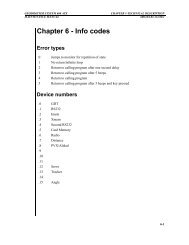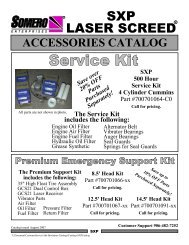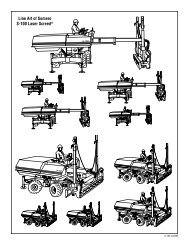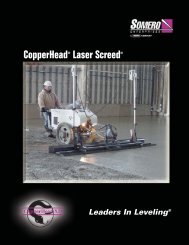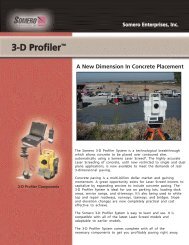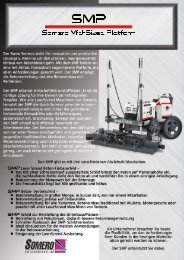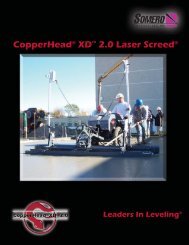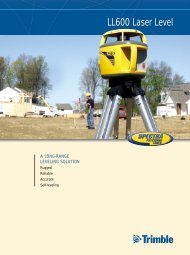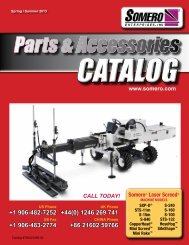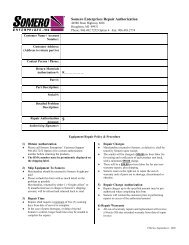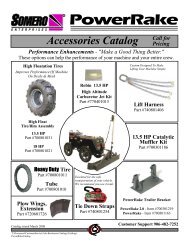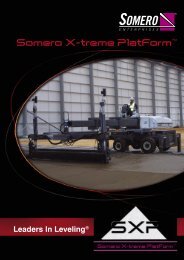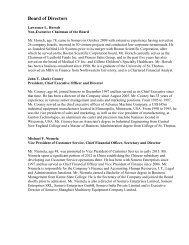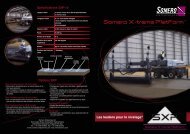PDF - Somero Enterprises
PDF - Somero Enterprises
PDF - Somero Enterprises
You also want an ePaper? Increase the reach of your titles
YUMPU automatically turns print PDFs into web optimized ePapers that Google loves.
Section 4<br />
Financial statements <strong>Somero</strong> <strong>Enterprises</strong>, Inc. and Subsidiaries<br />
Notes to the Consolidated Financial Statements<br />
As of 31 December 2006 and 2007<br />
1 Organisation and Description of Business<br />
Nature of Business <strong>Somero</strong> <strong>Enterprises</strong>, Inc. (the “Company” or “<strong>Somero</strong>”) designs, manufactures, refurbishes, sells and distributes concrete<br />
levelling, contouring and placing equipment, related parts and accessories, and training services worldwide. The operations are conducted<br />
from a corporate office in Jaffrey, New Hampshire, a single assembly facility located in Houghton, Michigan, a European distribution office<br />
in the United Kingdom, and sales offices in Canada and Germany.<br />
2 Summary of Significant Accounting Policies<br />
Basis of Presentation The consolidated financial statements of the Company have been prepared in accordance with accounting principles<br />
generally accepted in the United States of America.<br />
Principles of Consolidation The consolidated financial statements include the accounts of <strong>Somero</strong> <strong>Enterprises</strong>, Inc. and its subsidiaries.<br />
All significant intercompany transactions and accounts have been eliminated in consolidation.<br />
Cash and Cash Equivalents Cash includes cash on hand, cash in banks, and temporary investments with a maturity of three months or less<br />
when purchased.<br />
Accounts Receivable and Allowances for Doubtful Accounts Financial instruments which potentially subject the Company to concentrations<br />
of credit risk consist primarily of accounts receivable. The Company’s accounts receivable are derived from revenue earned from a diverse<br />
group of customers primarily located in the United States. The Company performs credit evaluations of its commercial customers<br />
and maintains an allowance for doubtful accounts receivable based upon the expected ability to collect accounts receivable. Reserves,<br />
if necessary, are established for amounts determined to be uncollectible based on specific identification and historical experience.<br />
As of 31 December 2006 and 2007, the allowance for doubtful accounts was approximately US$97,000 and US$191,000, respectively.<br />
Inventories Inventories are stated at the lower of cost, using the first in, first out (“FIFO”) method, or market. Provision for potentially<br />
obsolete or slow-moving inventory is made based on management’s analysis of inventory levels and future sales forecasts.<br />
Deferred Financing Costs Deferred financing costs incurred in relation to long-term debt, are reflected net of accumulated amortisation<br />
and are amortised over the expected repayment term of the debt instrument, which is four years from the debt inception date.<br />
These financing costs are being amortised using the effective interest method.<br />
Intangible Assets and Goodwill Intangible assets consist principally of customer relationships and patents, and are carried at their fair<br />
value, less accumulated amortisation. Intangible assets are amortised using the straight-line method over a period of three to 12 years,<br />
which is their estimated period of economic benefit. Goodwill is not amortised but is subject to impairment tests on an annual basis,<br />
and the Company has chosen 31 December as its periodic assessment date.<br />
The Company evaluates the carrying value of long-lived assets, excluding goodwill, whenever events and circumstances indicate the<br />
carrying amount of an asset may not be recoverable. For the years ended 31 December 2006 and 2007, no such events or circumstances<br />
were identified. The carrying value of a long-lived asset is considered impaired when the anticipated undiscounted cash flows from<br />
such asset (or asset group) are separately identifiable and less than the asset’s (or asset group’s) carrying value. In that event, a loss<br />
is recognised to the extent that the carrying value exceeds the fair value of the long-lived asset. Fair value is determined primarily<br />
using the anticipated cash flows discounted at a rate commensurate with the risk involved.<br />
Revenue Recognition The Company recognises revenue on sales of equipment, parts and accessories when persuasive evidence of an<br />
arrangement exists, delivery has occurred or services have been rendered, the price is fixed or determinable, and collectibility is reasonably<br />
assured. For product sales where shipping terms are F.O.B. shipping point, revenue is recognised upon shipment. For arrangements which<br />
include F.O.B. destination shipping terms, revenue is recognised upon delivery to the customer. Standard products do not have customer<br />
acceptance criteria. Revenues for training are deferred until the training is completed unless the training is deemed inconsequential<br />
or perfunctory.<br />
Warranty Reserve The Company provides warranties on all equipment sales ranging from three months to one year, depending on<br />
the product. Warranty reserves are estimated net of the warranty passed through to the Company from vendors, based on specific<br />
identification of issues and historical experience.<br />
32<br />
<strong>Somero</strong> <strong>Enterprises</strong>, Inc.<br />
Annual Report and Accounts 2007



